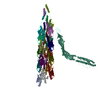+ Open data
Open data
- Basic information
Basic information
| Entry | Database: PDB / ID: 8tum | ||||||||||||||||||||||||
|---|---|---|---|---|---|---|---|---|---|---|---|---|---|---|---|---|---|---|---|---|---|---|---|---|---|
| Title | Type IV pilus from Pseudomonas PAO1 strain | ||||||||||||||||||||||||
 Components Components | Type IV major pilin protein PilA | ||||||||||||||||||||||||
 Keywords Keywords | MEMBRANE PROTEIN / Type IV pilus / T4P / PAO1 | ||||||||||||||||||||||||
| Function / homology |  Function and homology information Function and homology informationtype IV pilus / single-species biofilm formation on inanimate substrate / type IV pilus-dependent motility / cell adhesion involved in single-species biofilm formation / pilus / regulation of calcium-mediated signaling / host cell endoplasmic reticulum membrane / cell surface / plasma membrane / cytosol Similarity search - Function | ||||||||||||||||||||||||
| Biological species |  Pseudomonas aeruginosa PAO1 (bacteria) Pseudomonas aeruginosa PAO1 (bacteria) | ||||||||||||||||||||||||
| Method | ELECTRON MICROSCOPY / single particle reconstruction / cryo EM / Resolution: 3.6 Å | ||||||||||||||||||||||||
 Authors Authors | Thongchol, J. / Zhang, J. / Zeng, L. | ||||||||||||||||||||||||
| Funding support |  United States, 7items United States, 7items
| ||||||||||||||||||||||||
 Citation Citation |  Journal: Science / Year: 2024 Journal: Science / Year: 2024Title: Removal of type IV pili by a small RNA virus. Authors: Jirapat Thongchol / Zihao Yu / Laith Harb / Yiruo Lin / Matthias Koch / Matthew Theodore / Utkarsh Narsaria / Joshua Shaevitz / Zemer Gitai / Yinghao Wu / Junjie Zhang / Lanying Zeng /  Abstract: The retractile type IV pilus (T4P) is important for virulence of the opportunistic human pathogen . The single-stranded RNA (ssRNA) phage PP7 binds to T4P and is brought to the cell surface through ...The retractile type IV pilus (T4P) is important for virulence of the opportunistic human pathogen . The single-stranded RNA (ssRNA) phage PP7 binds to T4P and is brought to the cell surface through pilus retraction. Using fluorescence microscopy, we discovered that PP7 detaches T4P, which impairs cell motility and restricts the pathogen's virulence. Using cryo-electron microscopy, mutagenesis, optical trapping, and Langevin dynamics simulation, we resolved the structure of PP7, T4P, and the PP7/T4P complex and showed that T4P detachment is driven by the affinity between the phage maturation protein and its bound pilin, plus the pilus retraction force and speed, and pilus bending. Pilus detachment may be widespread among other ssRNA phages and their retractile pilus systems and offers new prospects for antibacterial prophylaxis and therapeutics. | ||||||||||||||||||||||||
| History |
|
- Structure visualization
Structure visualization
| Structure viewer | Molecule:  Molmil Molmil Jmol/JSmol Jmol/JSmol |
|---|
- Downloads & links
Downloads & links
- Download
Download
| PDBx/mmCIF format |  8tum.cif.gz 8tum.cif.gz | 672.5 KB | Display |  PDBx/mmCIF format PDBx/mmCIF format |
|---|---|---|---|---|
| PDB format |  pdb8tum.ent.gz pdb8tum.ent.gz | 559.3 KB | Display |  PDB format PDB format |
| PDBx/mmJSON format |  8tum.json.gz 8tum.json.gz | Tree view |  PDBx/mmJSON format PDBx/mmJSON format | |
| Others |  Other downloads Other downloads |
-Validation report
| Summary document |  8tum_validation.pdf.gz 8tum_validation.pdf.gz | 836.5 KB | Display |  wwPDB validaton report wwPDB validaton report |
|---|---|---|---|---|
| Full document |  8tum_full_validation.pdf.gz 8tum_full_validation.pdf.gz | 836.5 KB | Display | |
| Data in XML |  8tum_validation.xml.gz 8tum_validation.xml.gz | 48.9 KB | Display | |
| Data in CIF |  8tum_validation.cif.gz 8tum_validation.cif.gz | 82.6 KB | Display | |
| Arichive directory |  https://data.pdbj.org/pub/pdb/validation_reports/tu/8tum https://data.pdbj.org/pub/pdb/validation_reports/tu/8tum ftp://data.pdbj.org/pub/pdb/validation_reports/tu/8tum ftp://data.pdbj.org/pub/pdb/validation_reports/tu/8tum | HTTPS FTP |
-Related structure data
| Related structure data |  41625MC  8tuwC  8tuxC M: map data used to model this data C: citing same article ( |
|---|---|
| Similar structure data | Similarity search - Function & homology  F&H Search F&H Search |
- Links
Links
- Assembly
Assembly
| Deposited unit | 
|
|---|---|
| 1 |
|
- Components
Components
| #1: Protein | Mass: 14878.889 Da / Num. of mol.: 16 / Source method: isolated from a natural source / Source: (natural)  Pseudomonas aeruginosa PAO1 (bacteria) / Strain: PAO1 / References: UniProt: P04739 Pseudomonas aeruginosa PAO1 (bacteria) / Strain: PAO1 / References: UniProt: P04739Has protein modification | Y | |
|---|
-Experimental details
-Experiment
| Experiment | Method: ELECTRON MICROSCOPY |
|---|---|
| EM experiment | Aggregation state: FILAMENT / 3D reconstruction method: single particle reconstruction |
- Sample preparation
Sample preparation
| Component | Name: Type IV twitching pilus / Type: ORGANELLE OR CELLULAR COMPONENT / Entity ID: all / Source: NATURAL |
|---|---|
| Molecular weight | Value: 0.24 MDa / Experimental value: NO |
| Source (natural) | Organism:  |
| Buffer solution | pH: 7.4 Details: 137 mM NaCl, 2.7 mM KCl, 8 mM Na2HPO4, and 2 mM KH2PO4, pH 7.4 |
| Buffer component | Conc.: 1 x / Name: PBS |
| Specimen | Embedding applied: NO / Shadowing applied: NO / Staining applied: NO / Vitrification applied: YES |
| Vitrification | Instrument: FEI VITROBOT MARK II / Cryogen name: ETHANE / Humidity: 80 % |
- Electron microscopy imaging
Electron microscopy imaging
| Experimental equipment |  Model: Titan Krios / Image courtesy: FEI Company |
|---|---|
| Microscopy | Model: FEI TITAN KRIOS |
| Electron gun | Electron source:  FIELD EMISSION GUN / Accelerating voltage: 300 kV / Illumination mode: FLOOD BEAM FIELD EMISSION GUN / Accelerating voltage: 300 kV / Illumination mode: FLOOD BEAM |
| Electron lens | Mode: BRIGHT FIELD / Nominal defocus max: 2200 nm / Nominal defocus min: 1200 nm / C2 aperture diameter: 100 µm |
| Specimen holder | Cryogen: NITROGEN / Specimen holder model: FEI TITAN KRIOS AUTOGRID HOLDER |
| Image recording | Electron dose: 50.85 e/Å2 / Film or detector model: GATAN K3 (6k x 4k) / Num. of real images: 5085 |
- Processing
Processing
| CTF correction | Type: NONE |
|---|---|
| Particle selection | Num. of particles selected: 25763 |
| 3D reconstruction | Resolution: 3.6 Å / Resolution method: FSC 0.143 CUT-OFF / Num. of particles: 14424 / Symmetry type: POINT |
 Movie
Movie Controller
Controller







 PDBj
PDBj
